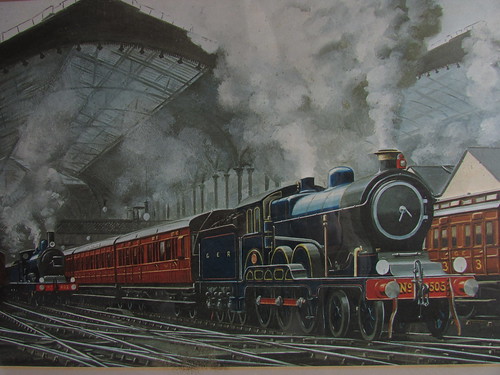
Locomotive 1505 leaving Liverpool Street ('Proud Steam' by C. Hamilton-Ellis).
Although the Great Eastern Railway was absorbed into the London and North Eastern Railway following the Railways Act of 1921 which combined Britain's railways into four Groups, much of the railway's distinctive flavour survived. Unfortunately, being brought up in the West Midlands I didn't have much opportunity to savour that flavour.
Probably my first visit to a former Great Eastern station was in 1951, when my mother took me to the Festival of Britain celebrations in London. We were both impressed by the South Bank site. But I insisted on visiting a number of the main line terminal stations in London, including the former Great Eastern terminus at Liverpool Street.
Sometime later, my mother and I travelled, by train, to an appointment she had in March (the town). A brief introduction, I'm afraid, to a railway of great character.
Over the years I made various train journeys to places on the former Great Eastern network like Cambridge and Ipswich and once went from Stratford (Low Level) to Woolwich in a 2-car DMU. On that journey, I still remember the sense of dereliction hanging over the area around Silvertown. Part of that route is now used by the Docklands Light Railway.
In the 1990s, I visited Sheringham a couple of times by train to visit the marvellous North Norfolk preserved railway, where I was a "guest driver" on 'Ladies Days'. I got to drive the amazing 'B12'. As the '1500' class (shown in the picture above in the handsome livery of the Great Eastern), this long-lived class was one of the star performers on the Great Eastern.
More recently, on 30th July 2011, I travelled to Chelmsford by train to attend Lionsmeet 2011. On 1st July 2013 I travelled to Ely (described here) and, on 8th September 2014, I looked at the Great Eastern in the London Area (and wrote about it here). In January 2017, I made another journey from Liverpool Street to Stratford, described in the post Interlude in London.
The 'Jazz' service
Prior to the electrification of its suburban services in 1960, Liverpool Street was famous for its intensive steam-hauled local trains, known as the 'Jazz', introduced in 1920. This service is recalled by Keith Jaggers in an article here and there's an excellent analysis of the 'Jazz' services in the post The Development of timetables at Liverpool Street station over the past 100 years.
Great Eastern Railway Society
The Great Eastern Railway Society website has comprehensive information about the railway (and a shop).
Signalling
The Great Eastern was distinctive in signalling matters and used 'somersault' semaphore signals widely. These display a conventional horizontal arm when 'on' but, in the 'off' position, the spectacle turns so as to change the filter displayed in front of the lamp in the conventional manner but the arm pivots away from the spectacle at an angle usually exceeding 45 degrees, giving the appearance of being broken! The advantage of this arrangement is that, during the day, the position of the arm is easier to read at a distance.
Locomotive Headcodes
The Great Eastern also had its own, complex, arrangement of headcodes on locomotives, justified by the intensity of suburban services operated. I discussed this, briefly, in the post British Locomotive Headcodes, which has links to more information on the Great Eastern Railway Society website.
The East London Railway
Marc Brunel's Thames Tunnel never managed to provide a cross-river link for horse-drawn vehicles, as was the original intention, but its dimensions allowed it to be adapted for rail traffic. In 1865, the Great Eastern Railway was one of the six subscribers to the East London Railway which purchased the tunnel and converted it for railway use.
The six railways in this joint venture were:-
Great Eastern Railway
Metropolitan Railway
District Railway
London, Brighton & South Coast Railway
London, Chatham and Dover Railway
South Eastern Railway
There's a brief history of this interesting line here.
Maps
The Great Eastern Railway connections around London are shown on the Railway Clearing House maps. These are linked below:-
Great Eastern around Liverpool Street.
Great Eastern connections south of the Thames via the East London Railway.
Great Eastern around Stratford.
Great Eastern around Millwall and Poplar.
Book References
[1] ‘Great Eastern Album’ by R. C. Riley (Ian Allan) ISBN 7110 0063 8.
[2] ‘The Great Eastern Railway’ by C. J. Allan (5th edition paperback Ian Allan 1975) ISBN 07110 0659 8.
Related posts on other sites
Great Eastern Railway Society.
Great Eastern Railway.
Liverpool Street, and all that Jazz (PDF).
Related posts on this site
The Great Eastern in the London Area.
Interlude in London
East London Line.
My Pictures
Where necessary, clicking on an image above will display an 'uncropped' view or, alternately, pictures from may be selected, viewed or downloaded, in various sizes, from the albums listed:-
Ely Station.
London: Former Great Eastern Line.
